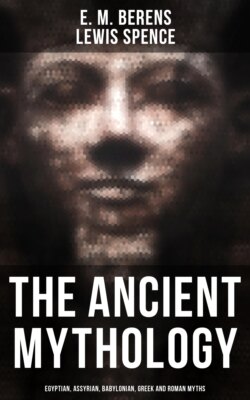Читать книгу The Ancient Mythology: Egyptian, Assyrian, Babylonian, Greek and Roman Myths - Lewis Spence - Страница 107
На сайте Литреса книга снята с продажи.
Asshur
ОглавлениеThe state religion of Assyria centres in Asshur, nor was any deity ever so closely identified with an empire as he. On the fall of the Assyrian state, Asshur fell with it. Moreover all the gods of Assyria may be said to have been combined in his person. In Babylonia, Merodach was a leader of hosts. In Assyria, Asshur personified these hosts, that is, the other Assyrian gods had become attributes of Asshur, and we can only understand the remaining Assyrian gods if we regard them as lesser Asshurs, so to speak, as broken lights of the great god of battle and conquest.
Symbols of the God Asshur.
Asshur originated in the city of his name situated on the west bank of the Tigris, not far from the point where the lower Zab flows into that river. It was not of course until the rise of this city to political pre-eminence that its god figured as all-powerful. There are conflicting estimates as regards his original nature, some authorities holding that he was lunar, others that he symbolized fire or water. The facts, however, point to the conclusion that he was solar in character.
Merodach had chiefly been worshipped in Babylon. As other Babylonian territories became subject to that city we do not find them placing the god of Babylon above their own local god. But it was different with Asshur. We find temples to him broadcast over Assyria. Indeed as Assyrian history advances, we see different cities alluded to as the chief centre of his worship, and he resides now at Asshur, now at Calah, now at Nineveh, now at Khorsabad. Wherever the Kings of Assyria took up their official residence there Asshur was adored, and there he was supposed to dwell. He was not symbolized by an idol or any man-like statue which would serve to give the populace an idea of his physical likeness, but was represented by a standard consisting of a pole surrounded by a disc enclosed with two wings. Above the disc was the figure of a warrior with bent bow and arrow on string. This well symbolized the military nature of the Assyrian nation and of its tutelar deity. At the same time indications are not wanting that this pole and its accompanying symbols are the remains of a totem-standard upon which has been superimposed the anthropomorphic figure of a lightning- or tempest-god. The pole is a favourite vehicle for carrying the totem symbols into battle, and it looks here as if the sun had at one time been regarded as a tribal totem. The figure of the archer at the top seems representative of a lightning- or storm-god—a mythic character frequently associated with the sun, that 'strong warrior.' By virtue of his possession of the lightning arrow the storm-god is often accepted as a god of war.
The etymology of the name of Asshur throws little light upon his character as a divinity. The city which took his name was in all probability originally called 'The city of the god Asshur.' To call it by the name of the god alone would not be unnatural. The name is derived from a root meaning 'to be gracious,' and therefore means 'the gracious god,' 'the good god.' But there are indications that an older form of the name had existed, and it has been asserted that the form Anshar has priority. With Kishar, a god Anshar was created as the second pair of deities to see the light, and according to one version it is Anshar who dispatches Anu, Ea, and finally Merodach to destroy the monster Tiawath. This Anshar, then, appears as possessed with authority among the gods. But we find no mention of him in the ancient texts and inscriptions of Babylonia. The version in which Anshar is alluded to may of course have been tampered with, and his inclusion in the creation myth may be regarded as a concession to Assyrian greatness. Indeed in one creation tablet we find Merodach displaced by Asshur as framer of the earth!
